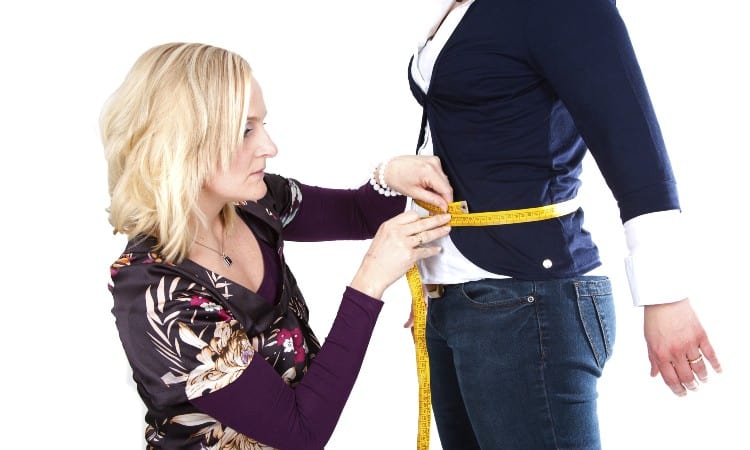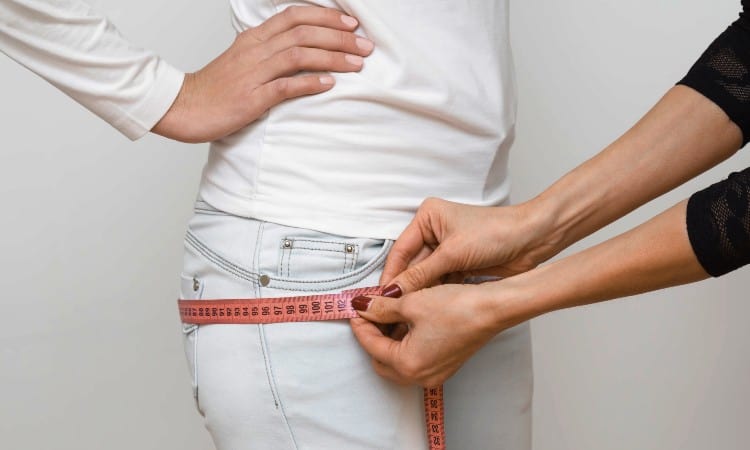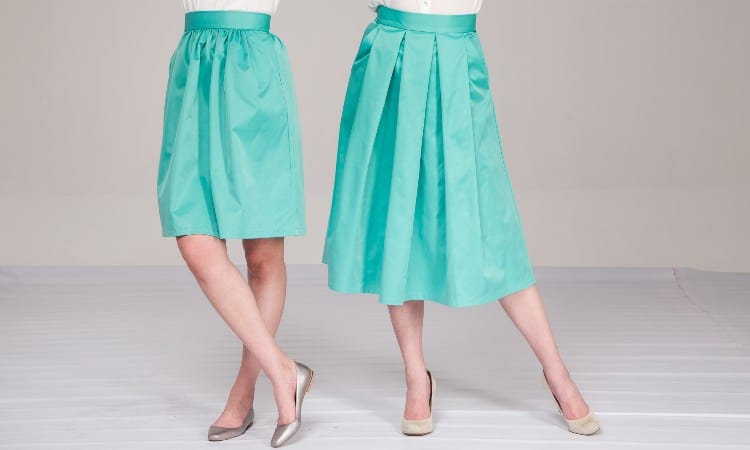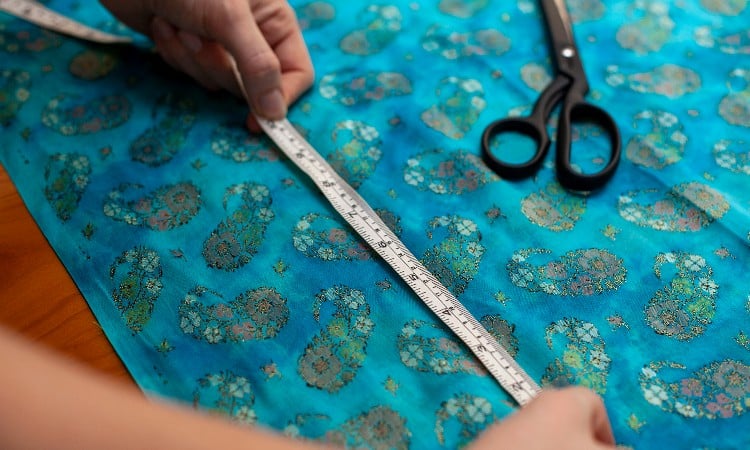Does it drive you crazy to put the perfect skirt in your online shopping cart, then realize that it doesn’t fit you once the package arrives? Unless you want to go to a brick-and-mortar store and try on dozens of skirts every time you need a new one, you can save yourself a ton of time by learning how to measure a skirt. This way, you will always know what size of skirts to put in your online shopping cart!
The key measurements to determine skirt size include waist, hip, length, and hemline width. Skirts come in many popular shapes and sizes, so measuring a style of skirt you like, such as a pencil or peasant skirt, can help determine the best size. Skirt measurement hacks, such as measuring the waist based on the length of the forearm, can also serve as a guide for fit.
In this article, you will learn how to measure yourself to find the right skirt size for you. You will discover how to compare your measurements to a skirt size chart. Finally, you will find tips and hacks for how to quickly determine if a skirt will fit you.

How to Measure a Skirt
The key measurements for a skirt include the waist and hip width and the length from waistband to hemline. In some cases, it also helps to measure the hemline width to know the fullness of the skirt.
How do you measure a skirt with a measuring tape? First, use a flexible measuring tape like the kind you can find in a sewing kit. These fabric or plastic-coated fabric tapes can bend around your shape and help you accurately determine widths.
Second, make sure you keep the tape level as it wraps around your body. Using a mirror to see your back helps, but the best method is to ask a friend to measure you.
Finally, keep in mind that skirts come in dozens of different lengths and styles. This means that part of measuring for a skirt means determining what length and fullness will look good on your body rather than picking a specific “correct” length.
1. Measure a Skirt
One easy way to learn your perfect skirt measurements is to measure a skirt you already own that fits you well. The only catch here is that you need to measure a skirt in the same style as the new model you want to buy. For example, if you want to buy a new pencil skirt, get your measurements to form an old pencil skirt that fits you well.
Likewise, if you want to know your measurements for a maxi skirt, measure a maxi skirt that fits you well. Different styles of skirts fit you differently, meaning they may require slightly different measurements.
To measure a skirt:
- Spread out the skirt on a flat surface like a carpet or table. Make sure it lies smooth and does not have any wrinkles.
- Stretch the tape measure across the top edge of the waistband. Write down this number, then multiply it by 2 to get the full waist circumference.
- Next, measure 8 inches down from the top of the waistband at one side seam, and insert a small safety pin to mark this point. Repeat this process on either side seam. Then measure straight across the skirt from one safety pin to the other, multiply that measurement by two, and write down your hip circumference.
- To find the length, measure straight down the skirt from the top of the waistband to the hemline.
- Finally, find the fullness of the skirt by measuring the width of the hemline. Measure straight across the skirt from one side seam to the other at the hemline, and then multiply that measurement by two.
2. Waist

One of the most important measurements you can take on yourself to find your skirt size is your waist circumference.
- Find your natural waist, a point about one inch below your navel. When looking in a mirror, this often looks like the most narrow part of your torso.
- Wrap a tape measure around your waist at this point. Check over your shoulder in a mirror to make sure the tape stays level as it crosses the back of your waist.
- You want the tape to rest directly on your skin without any sagging or poofing out, but you also don’t want to pull it too tightly. Write down the measurement where both ends of the tape meet after circling your waist.
- If you want a relaxed-fit skirt, you may want to add half an inch to your waist measurement. And for an elastic-waist style like some maxi skirts, subtract half an inch from the measurement.
3. Hips

The single most important measurement you need to get a skirt size that fits you is the hip circumference. This measurement is important because the hips typically form the widest part of your lower body. If you get a skirt in a size that does not stretch as wide as your hip measurement, it will not fit you!
- The key to accurate hip measurement is locating the fullest part of your hips and your seat. This does not often mean the point where the tips of your hip bones stick up, which can seem confusing! Instead, look in a mirror and stretch the tape in a straight line around the widest part of your rear and around the most outwardly curved portion of your hips.
- If this seems too confusing, you can also take this measurement at a point eight inches below your natural waist. But the eight-inch marker is a general guideline. You will do better if you try to find the fullest point on your own body, which could fall seven inches below your waist or even nine inches below, depending on your proportions.
- Make sure the tape stays level.
- Write down the number when the ends of the tape meet.
4. Length
Measuring yourself for skirt length is less clear-cut because skirts come in many different lengths and styles. Here you can find guidelines for how to find the right length for popular skirt styles like mini, midi, knee length, and full length.
- First, stand up straight in a good but relaxed posture. Either position yourself in front of a mirror or ask a friend to help.
- Hold the short end of the tape measure at the center of your natural waist. Let the tape fall so it hangs straight in front of you.
- Now you need to determine where you want the skirt to end on your body. This varies a lot depending on the kind of skirt you want.
- For a mini skirt, you want the hem to end in the middle of your thigh or four to five inches below your rear end.
- Many skirts, like pencil skirts and most A-line skirts, have an above-the-knee hemline. This means you want the skirt to end just before the bony part of your kneecap begins.
- Below-the-knee skirts have a hemline that falls just below your bony kneecap.
- Midi skirts cover a huge range of skirt styles, from fully pleated skirts to straight skirts with slits up the back. These skirts should end halfway down your calf. Another name for this length is the tea-length skirt, which technically should fall four inches below your knee.
- Maxi skirts should hang just above your ankle bone.
- Full-length skirts should hang all the way to the floor when you stand on your bare feet.
All you have to do is mark the tape measure at the right point on your body and then write down that length!
Finally, keep in mind the golden rule for flattering hem lengths: the hemline should end at the skinniest part of that portion of your body. This means that for a midi skirt, the hem should end at the skinniest part of your calf. For a mini skirt, it should end at the point of your thigh where the thigh curves in instead of out.
This rule helps you present an elegant, elongated image of yourself, whether tall or short, thin or curvy!
5. Hemline Width
Hemline width tells you the fullness of the skirt at its widest point, the hemline. Generally speaking, you would take this measurement more often on an actual skirt than on yourself. You can find instructions for that process in the section on “how to measure a skirt” earlier in this article.
But you may find it helpful to measure the width of your legs at the hemline point to make sure the skirt is wide enough to fit. To do this, all you need is to wrap a tape measure around your legs at the point where the hemline will hit your legs. Then write down the number and compare it to the hemline measurement listed in the product description for the garment.
This matters especially with tightly fitting, stretchy, or slitted skirts.
6. Without a Tape Measure
While the most accurate way to measure yourself for a skirt is to use a tape measure, you can substitute a length of twine, ribbon, or rope if you do not have a measuring tape handy.
Sometimes you just need to make a quick decision about an online deal and don’t have time to hunt for a real tape measure.
- In this case, grab anything soft and flexible with enough length to wrap around your body.
- Follow the steps described above to take your measurements, but pinch the rope a the ending point for each measurement this time.
- Line up the rope against a rule or metal tape measure and find the specific measurement in inches for the length of rope you pinched off.
Skirt Measurement Chart for Sewing
This chart will give you an overview of the common measurement sussed for different kinds of skirts in sewing. Keep in mind that just like retail clothing, different brands of sewing patterns will have unique measurements and sizing. So make sure you always check the sizing chart on the back of a pattern envelope before you begin!
Skirt Measurement in Inches:
| Size | Waist | Hips |
| 4 | 24 | 33 |
| 6 | 25 | 34 |
| 8 | 26 | 35 |
| 10 | 28 | 37 |
Skirt Measurement in CM:
| Size | Waist | Hips |
| 4 | 60 | 83.5 |
| 6 | 62.5 | 86 |
| 8 | 65 | 88.5 |
| 10 | 70 | 93.5 |
Another way to figure out skirt measurements before picking a sewing pattern is to use an online skirt measurement calculator. A dress size calculator like this one asks for your bust, waist, and hip measurement and then estimates your clothing size based on that data.
How to Measure Special Skirts

Now that you know the essential measurements needed to figure out your skirt size check out these tips for how to measure specific kinds of skirts.
Straight Skirt
A straight or pencil skirt should fit you lightly, skimming over all your curves without any sagging or stretching. The challenge with a skirt that so closely fits the shape of your body is that if it does not have the same curves as you do, you can often end up with draglines or wrinkles across the front of the skirt, making it look as if the garment is too small for you.
To avoid this, take extra care with your measurements:
- As always, start by getting a good waist measurement.
- But for the hip measurement, you will break down the one typical circumference into three different measurements to make sure you accurately outline your curves. First, measure around your upper hip at a point three inches below your waist.
- Second, measure midway down your hip, six inches below your waist.
- Finally, measure the full point of your hip, eight to nine inches below your waist.
You may not find all these measurements listed in a product description, but you can always measure a new skirt yourself to see if it will fit you. Taking these additional hip measurements also helps a lot of you want to sew your own pencil skirt.
Mini Skirt
To measure yourself for a mini skirt, follow the steps described earlier in this article, but keep these tips in mind:
- In general, you want a mini skirt hemline to end about four inches below the curve of your bottom. When you try on a new skirt, sit down and stand up several times to ensure you can do this without revealing anything you don’t want to!
- Avoid the “short and tight” look. Your mini-skirt needs to fit you closely at the waist, but it should just skim over your hips and it should not pull tightly at your thighs.
- Finally, mini skirts tend to look best on people with petite frames. If you have a taller, larger, or curvier build, you may want to highlight your own unique shape with a different style of skirt.
Long Skirt
Long skirts come in several different styles, like floor-length, midi, and maxi-length skirts. A common struggle people face when measuring for a long skirt is learning how to factor in the height of your shoes or heels. This “magic formula’ will help you get that measurement right every time!
You do need to take this measurement using centimeters, not inches. So check the opposite side of your tape measure to see if it uses the metric system before you begin.
- Put on the shoes or heels you want to wear with the skirt.
- Stand in front of a mirror and position yourself so that you have good posture, with your arms hanging lightly at your sides.
- Have a friend hold the short end of the tape at the shoulder seam in your shirt.
- Let the tape fall all the way to the floor.
- Write down the measurement from eh point where the tape touches the floor.
- Divide that number by 1.618.
- This new measurement gives you the ideal distance from shoulder to hemline for your skirt as you wear those shoes.
- To find that point on your body, measure again from your shoulder to the new measurement length.
Girls Skirts
You use the same waist, hip, and length measurements to find the right size skirt for a girl. But toddler, child, and junior sizes all use different names and measurements than women’s sizes. Plus, many clothing manufacturers use weight and height as deciding factors for child clothing sizes.
This table gives you an idea of the average measurements used to determine child skirt sizes:
| Size | Height | Weight | Waist | Hip |
| 2T | 35”-36” | 27-28 lbs | 21” | 21” |
| 4T | 39”-41” | 33-36 lbs | 22” | 23” |
| XS or child size4-5 | 39”-41” | 33-36 lbs | 22” | 23” |
| S or child size 6 | 45”-46” | 41-46 lbs | 23” | 25” |
| M or child size 7-8 | 49”-52” | 51-63 lbs | 23”-24” | 26”-28” |
| L or child size 10-12 | 53”-58” | 64-84 lbs | 23”-26” | 26”-32” |
How To Measure Fabric for a Skirt

The steps you take to measure fabric for a skirt depend on the kind of skirt you want to sew. Check out these tips to learn how to measure fabric for a circle, pencil, and gathered skirt.
These formulas give you a handy metric, but they require a bit of math. Remember that you can also read the back of a sewing pattern to find out how much material you need for a specific style of skirt.
Circle Skirt
Though this does vary depending on your size, most circle skirts require about 2.5 yards of fabric.
A circle skirt uses a lot of fabric because you cut out a giant circle of fabric to form it. To determine how much fabric you need, follow this formula: your waist measurement divided by 3.14, plus skirt length, plus two inches for the seam allowance. Finally, multiply the total by two.
For example, if you have a waist measurement of 35”, divide that by 3.14 to get 11.14. Round that to 11.5 inches for convenience, and then add the length of the skirt plus two extra inches.
So if you want your skirt to have a length of 30 inches, you would add 11.5 to 30 for a total of 41.5. Then add two more inches for a total of 43.5, and multiply by two to get 87 inches.
Since fabric comes in yards and each yard encompasses 36 inches, divide your total by 36 to find out how many yards of material you need for your skirt. In this example, 87/36 = 2.41, which you should just round up to two and a half yards.
Pencil Skirt
Most pencil skirts need only about one yard of fabric.
- To figure out how much yardage you need, take your hip measurements, and add two inches to the measurement for seam allowance.
- Then decide where you want the skirt to end on your legs and take a length measurement. Write down that number and add two inches to that as well.
- Multiply the hip measurement by the length measurement to find out the area of the fabric you need in inches.
- Finally, divide that number by 1,296 (36 X 26, or one square yard) to determine the amount of fabric you need in yards.
For example, if you have a 36” hip measurement and add two inches to that, you get a total of 38. If you have a skirt length of 30 inches and add two inches for seam allowance, you get a total of 32. Multiply 32 by 38 for a total of 1,216 inches. This tells you the total area of fabric you need in inches.
To determine what this amounts to in yardage, multiply 36 X 36 to get the number of inches in a square yard (1,296). Divide 1,216 by the square yard total of 1,298. As you can see, you need less than one yard of fabric for your skirt!
Gathered Skirt
The amount of fabric you need for a gathered skirt depends on how full you want it, but generally, a gathered skirt will use quite a lot of material, often at least three yards.
To find the exact length of material you need for a gathered skirt:
- Measure your waist.
- For moderate fullness, multiply that number by 2.
- For extra fullness, multiply the waist measurement by 3.
- For example, if you have a waist measurement of 32”, multiply 32 X 3 to get 96”.
- To know how much fabric you need in yards, divide that total by 36”.
- For this example, 96/36 = 2.6.
What is the Average Length of a Skirt?
The average length of a skirt depends on its style, though the most commonly worn length is the knee-length skirt with a length of 23” on a woman with an average height of 5’5”.
Of course, all styles of skirts have an average length, such as an average length of 15” for mini skirts.
How To Measure a Skirt Waist Without Sewing
One easy hack you can use to measure a skirt’s waist without a tape measure or sewing is to use the forearm hack. This lets you quickly test out a waistband in a store and determine whether it will fit you with no dressing room or tape measure!
- Insert your forearm into the waistband of the skirt.
- Try to uncurl your fingers. Can you open your whole hand?
- If the waistband only reaches around your closed fist and you can’t open the length of your hand, it is too small!
You can also try wrapping the waist of the skirt around your neck, and if it meets around your neck, it should fit you!
What To Do if a Skirt is Too Big Around the Waist?
If a skirt is too big around the waist, you can fix it with a few simple methods, like taking it to a tailor, altering the side seams, or gathering it up with a shoelace.
- The most professional way to fix a too-big skirt is to take it to a tailor. Most tailors can make a skirt smaller in the waist for about $25-$45.
- If you have a sewing machine, you can easily take in the side seams of most skirts. You simply sew a new line of stitches inside the old line, making the circle of the waistband smaller.
- If it works with your outfit, wear a belt to keep a slightly-too-large skirt waistband from sagging or slipping.
- If you need to make your skirt smaller in the waist right away, try this hack: wrap a long shoelace around your waist, and knot it, so it does not slide up or down. Put on the skirt over the lace, and then tuck the waistband over the shoelace, hiding it and holding the skirt firmly to your waist.
How to Tell if a Skirt Fits Without Trying It On
You can tell if a skirt will fit you without trying it on by comparing your measurements to the sizing chart provided by the clothing manufacturer. This way, you can quickly see if the waist, hip, and length measurements will line up with the shape of your body.
Some brands list average height and weight guides instead. This is easier for the consumer because you just need to see what column your height and weight put you into, but it is less specific and does not tell you for sure if a tight skirt will fit over your hips properly.
Conclusion
Learning how to take key skirt measurements like the waist, hip, and skirt length will help you find skirts that fit you every time. Different styles of skirts have a special length, like mid-thigh for a mini skirt versus mid-calf for a midi skirt. Figuring out that length in inches on your own body will help you wear skirts that look right on your particular shape.
If you want to sew your own skirts, you can also use your measurements plugged into special formulas to determine how many yards of fabric you will need to make a skirt. This also allows you to take special measurements, like additional hip measurements for a pencil skirt, to ensure that a skirt tailors its shape to the shape of your body.